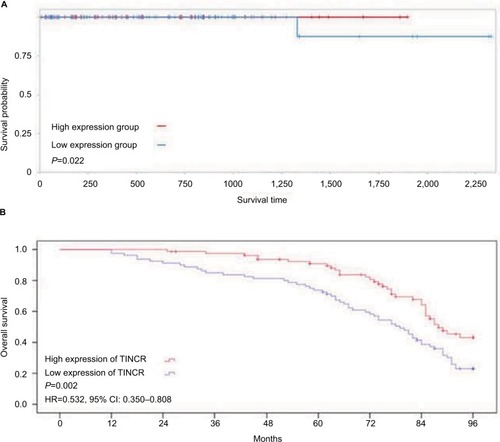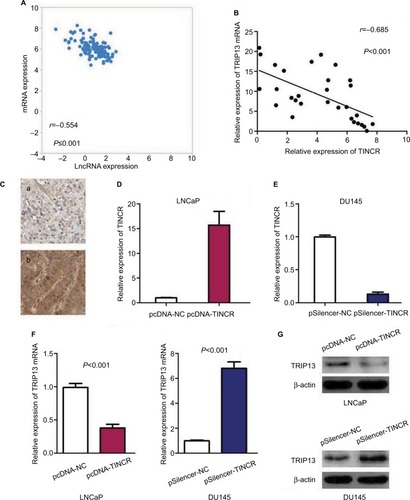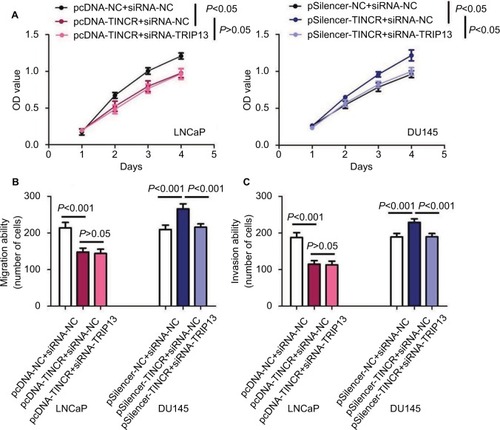Figures & data
Figure 1 Levels of TINCR expression are decreased in prostate cancer tissues and cell lines.
Notes: (A) TINCR expression is significantly decreased in prostate cancer tissues compared with paired normal prostatic tissues (clinical samples from TCGA database). (B) TINCR levels are obviously reduced in prostate cancer tissues compared with paired normal prostatic tissues (clinical samples from our study). (C) TINCR has a lower expression level in prostate cancer cell lines (LNCaP, PC3, DU145 and 22Rv1) compared with normal human prostate epithelial cell lines (RWPE-1 and P69).
Abbreviations: TINCR, terminal differentiation-induced non-coding RNA; TCGA, The Cancer Genome Atlas.

Table 1 Correlations between TINCR expression and clinicopathological characteristics in prostate cancer
Figure 2 Low expression of TINCR predicts a poor prognosis in prostate cancer patients.
Notes: (A) Prostate cancer patients with low expression of TINCR have a shorter survival time than those with high expression of TINCR (clinical samples from TCGA database). (B) Level of TINCR is positively correlated with the overall survival of prostate cancer cases (clinical samples from our study).
Abbreviations: TINCR, terminal differentiation-induced non-coding RNA; TCGA, The Cancer Genome Atlas.

Table 2 The association between TINCR and TRIP13 protein in prostate cancer
Figure 3 The relationship between TINCR and TRIP13 in prostate cancer.
Notes: (A) TINCR expression is markedly negatively correlated with TRIP13 mRNA expression in prostate cancer tissue samples from TCGA database. (B) Levels of TINCR expression are negatively associated with TRIP13 mRNA expression in prostate cancer tissue samples from our study. (C) Immunohistochemical staining of TRIP13 in prostate cancer tissues: a, low-expression of TRIP13; b, high-expression of TRIP13. (D) The efficiency of pcDNA-TINCR is confirmed by qRT-PCR in LNCaP. (E) The efficiency of pSilencer-TINCR is confirmed by qRT-PCR in DU145. (F) Upregulation of TINCR expression reduces TRIP13 mRNA expression in LNCaP cell, and downregulation of TINCR expression increases TRIP13 mRNA expression in DU145 cell. (G) Upregulation of TINCR expression decreases TRIP13 mRNA expression in LNCaP cell, and downregulation of TINCR expression elevates TRIP13 mRNA expression in DU145 cell.
Abbreviations: qRT-PCR, quantitative RT-PCR; TINCR, terminal differentiation-induced non-coding RNA; TCGA, The Cancer Genome Atlas.

Figure 4 The biological function of TINCR and TRIP13 regulates cell proliferation, migration and invasion in prostate cancer.
Notes: (A) The effect of TINCR and/or TRIP13 on prostate cancer cell proliferation. (B) The effect of TINCR and/or TRIP13 on prostate cancer cell migration. (C) The effect of TINCR and/or TRIP13 on prostate cancer cell invasion.
Abbreviations: OD, optical density; TINCR, terminal differentiation-induced non-coding RNA.

